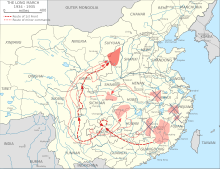
Back Lang mars Afrikaans المسيرة الطويلة Arabic Llarga Marcha AST اۇزون یورویوش AZB Langa Marsch BAR Дългият марш Bulgarian দীর্ঘ অভিযাত্রা Bengali/Bangla Llarga Marxa Catalan Uâng-lī Diòng-cĭng CDO Dlouhý pochod Czech
| Long March | |||||||||||||||||||||||
|---|---|---|---|---|---|---|---|---|---|---|---|---|---|---|---|---|---|---|---|---|---|---|---|
| Part of Chinese Civil War | |||||||||||||||||||||||
 Overview map Light red areas show Communist enclaves. Areas marked by a blue "X" were overrun by Kuomintang forces during the Fourth Encirclement Campaign, forcing the Fourth (north) and Second (south) Red Armies to retreat westward (dotted lines). The heavy dashed line is the route of the First Red Army from Jiangxi. The withdrawal of all three Red Armies ends in the northeast enclave of Shaanxi.[infobox clutter? – discuss] | |||||||||||||||||||||||
| |||||||||||||||||||||||
| Belligerents | |||||||||||||||||||||||
|
| ||||||||||||||||||||||
| Commanders and leaders | |||||||||||||||||||||||
| Strength | |||||||||||||||||||||||
| over 300,000 |
| ||||||||||||||||||||||
| Chinese name | |||||||||||||||||||||||
| Traditional Chinese | 長征 | ||||||||||||||||||||||
| Simplified Chinese | 长征 | ||||||||||||||||||||||
| |||||||||||||||||||||||
The Long March (Chinese: 长征; pinyin: Chángzhēng; lit. 'Long Expedition') was a military retreat by the Chinese Red Army and Chinese Communist Party (CCP) from advancing Kuomintang forces during the Chinese Civil War, occurring between October 1934 and October 1935. About 100,000 troops retreated from the Jiangxi Soviet and other bases to a new headquarters in Yan'an, Shaanxi, traversing some 10,000 kilometres (6,000 miles). About 8,000 troops ultimately survived the Long March.
After the defeat of the Red Army in Chiang Kai-shek's Fifth Encirclement Campaign, on 10 October 1934 the CCP decided to abandon its Jiangxi Soviet and headquarters in Ruijin, [Jiangxi]. The First Front Red Army of some 86,000 troops headed west, traveling over the rugged terrain of China's western provinces, including eastern Tibet. The Red Army broke several of Chiang’s blockades with heavy losses, and by the time it crossed the Xiang River on 1 December had only 36,000 men left. Its leaders, including Comintern military adviser Otto Braun and Moscow-trained Bo Gu, decided to take the troops through Hunan, but Chiang set up defenses to block their way. Mao Zedong, who was not a member of the Politburo, suggested going through Guizhou instead, which was accepted. On New Year's Day 1935, the Red Army crossed the Wu River, and a week later held the Zunyi Conference, which reduced Soviet influence in the Politburo and established Mao's position as de facto leader.
Employing guerrilla warfare, Mao maneuvered to avoid direct confrontation with Chiang's forces and led the Red Army out of encirclements by local warlords. The First Front Army met the Fourth Front Army, led by Zhang Guotao, in Maogong, Sichuan; they disagreed on the route to take to Yan'an and split up. The First Front Army arrived in Yan'an on 19 October 1935 with about 8,000 survivors, ending the Long March. The Fourth Front Army was largely destroyed by Chiang and Ma clique attacks, and its remnants joined the Second Front Army led by He Long. All three armies met on 22 October 1936.
Mao's leadership during the retreat brought him immense prestige and support among many within the otherwise-shattered Communist Party. It marked the beginning of his long ascent to primacy, and would be featured heavily in his public image, through the founding of the People's Republic.
Cite error: There are <ref group=lower-alpha> tags or {{efn}} templates on this page, but the references will not show without a {{reflist|group=lower-alpha}} template or {{notelist}} template (see the help page).